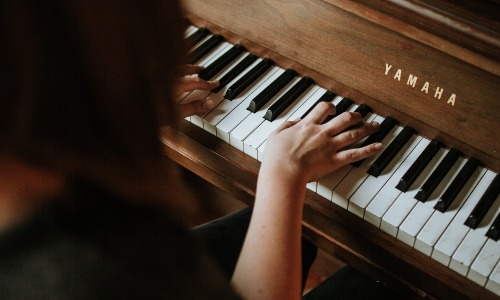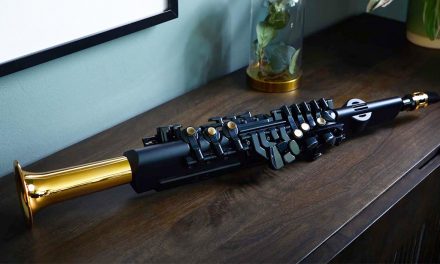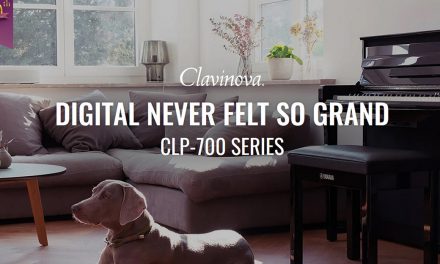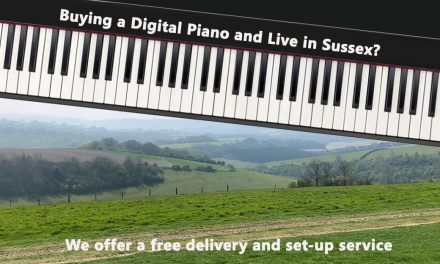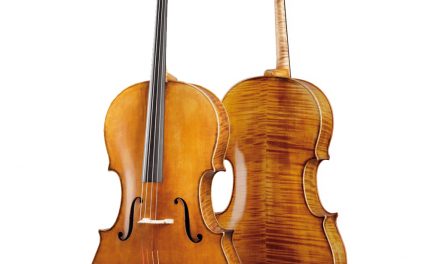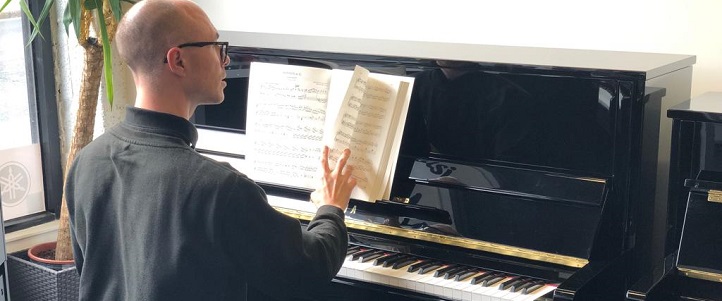
With a plethora of options available it can feel impossible to find the best way to start learning the piano. We’ve put our decades of combined knowledge together to give you a run-down of everything you could need to get going, from instruments, accessories, teaching materials: you name it!
Teaching Method:
Piano Teacher – Nothing beats an experienced teacher taking you through the techniques and introducing you to appropriate challenges at the right time. The immediate feedback you get from having time with someone there listening to you and watching your playing is invaluable, and can go a long way to prevent you falling into bad habits, or to help you unlock things you find obtuse. We keep a list of teachers local to our shops, or you can find teachers across the UK on websites like musicteachers.co.uk
App Assistance – You can get a decent amount of feedback from a tutorial app, using a phone or tablet to listen to your playing, and marking it for accuracy. It can give you the ability to play and progress in a more flexible manner, whenever you have free time. The most popular ones include Yousician and Flowkey.
Teach Yourself – There are a load of tutorial courses, free and paid for, available in a multitude of formats. Video tutorials from Youtube can be a great way to learn a particular song or technique, and many of the tutor books we sell have both written and audio/visual material, allowing you to play along and/or listen to what it should sound like. If you’re comfortable with your listening skills, or are moving on to piano from another instrument, then this can be a fine way to progress.
Instruments
Keyboards
When considering a keyboard we recommend you get something that is “touch sensitive.” This means the harder you press on the keys, the louder the note sounds (as you would expect on an acoustic piano.) Over time you learn how to play the notes differently to get dynamics and expression. It’s this kind of reaction that you only really get by practicing, and although a keyboard doesn’t fully replicate the feel of a piano, having this touch sensitivity is really important.
Casiotone CTS-300
An excellent touch-sensitive budget friendly starter keyboard. The retro-inspired, minimal design makes this keyboard stylish and practical.
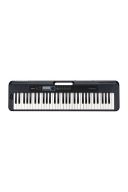
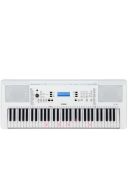
Yamaha EZ-300
The EZ series from Yamaha brings a really cool additional learning feature to students: light-up keys. The light up keys can be paired with dozens of songs to play along with, facilitating a really intuitive way to start learning – just follow the lights. Fun fact: even a chicken can play the keyboard with these light-up keys!
Stage Pianos
Stage pianos are electric pianos designed to be compact and light enough to be taken to a performing venue. They are generally an excellent value method of getting a “weighted” keyboard. A weighted keyboard means that each key is attached to a lever (with a weight on the end,) which simulates the way a hammer strikes a string in an acoustic piano. For those who want to play to an intermediate level, this feature is really essential.
Casio CDP-S100
Casio’s entry-level offering is the CDP-S100: a superb, lightweight and excellent value stage piano. With the bonus feature of optionally using batteries to power it, this keyboard can be used in almost any setting. We like these so much we use these as our rental digital piano.
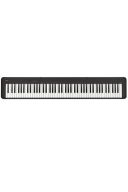
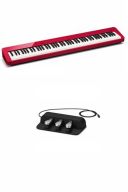
Casio PX-S1000 Editor’s choice
Out of all the compact options available we recommend the PX-S1000, which marks the cutting-edge in terms of what a stage piano is capable of. The quality of the keyboard (a fully-scaled weighting system, where each key response is different) and the additional features (battery power, bluetooth input, three-pedal unit) makes this a fantastic overall package.
Yamaha P125
Yamaha’s intermediate stage piano brings their excellent quality piano sound reproduction into a small package. If high fidelity piano / electric piano sounds are your thing this could very well be the choice for you. It also features a simple recording function, and dozens of songs included.
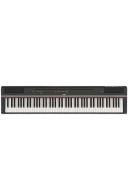
Digital Pianos
The majority of the more advanced digital pianos come as a single unit, where the keyboard and speakers are integrated into a dedicated wooden frame. It makes them more of a furniture piece, but really opens up the options in terms of components.
Casio PX-770 – The Privia series from Casio are their slimline digital pianos, generally the instrument will be a maximum of around 30cm deep. It packs a lot into this small space, with a fully scaled piano keyboard action, high quality speakers and 3-pedal bar. For those looking for a lot of instrument in a small space this (or it’s even more capable sibling the PX-870) is worth looking at.
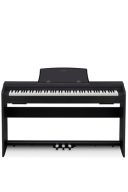
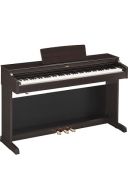
Yamaha YDP-164 – The “Arius” series from Yamaha comprises of instruments aimed at students. The 164 model introduces Yamaha’s more capable GH3 keyboard, meaning that each key is measured by three separate sensors. This extra capability means that this instrument will respond a lot closer to an acoustic piano than the earlier arius/compact models.
Yamaha CLP-735 – “Clavinova” has almost become synonymous with “digital piano” and Yamaha keep pushing the boundaries in what a digital piano can offer. Yamaha have been continually researching and iterating on their luxury range since 1983, and offer advanced sampling, and resonance modelling (expertly simulating the way sound travels through and away from a grand piano.) Look at the CLP-735 for synthetic keys or the next model, the CLP-745 for fully wooden keys.
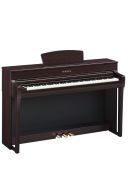
Hybrid Pianos
Hybrid Pianos combine the ergonomics of a full acoustic piano, with the added benefits of digital audio systems. Really the best of both worlds, and some of the best options available for many students.
Casio GP-310 – Editor’s Choice
The amount of care and precision taken to create this instrument is astonishing. The quality of the piano action in this instrument provides unprecedented authenticity in a digital instrument. This collaboration with Bechstein gives the top in class in terms of key response, digital audio controls and value for a hybrid piano.
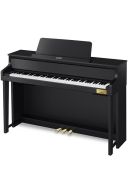
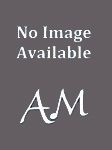
Yamaha B1-SC2
Not only does this compact acoustic piano give Yamaha’s peerless quality with their B1 fully-strung upright piano, the added silent system gives all the flexibility of a digital piano. Having the choice to play either the strings as a standard acoustic piano, or through the headphones system makes this Silent Piano series the perfect instrument for the 21st century student.
Teaching Material
There’s a lot of teaching material available for people embarking on the study of piano playing. Having a structured guide that introduces new concepts and techniques gradually means you don’t ever have too much to think about at once, and you can focus on the new element you’re learning, while the previous techniques become second nature through practice.
Here is an abridged list of piano tutor books for people with a range of interests and abilities:








.
Get Set Piano – This colourful and approachable tutor book is a great first learning book for children. It includes a wide range of activities that expand musicianship around piano playing.
.
Bastien Piano Basics – This classic course for children has a timeless charm in a colourful, playfully illustrated package. It is packed full of pieces to play, with plenty of scope to practice learning new pieces.
.
Piano Time – One of our all-time bestsellers, this method from Pauline Hall has a very clean and clear style, with a classic progressive style, gradually introducing more notes, and more complex tunes and duets as you go.
.
Piano Safari – Regarded as one of the best new piano methods released in recent years by piano teachers across the world, this method gradually progresses note reading while building up technique and listening skills through playing pieces.
.
John Thompson Pop – The John Thompson Method is one of the most well-established routes into piano learning, first published in 1936. Today, this pop adaptation incorporates modern music into the progressive method, allowing students to enjoy contemporary songs they are already familiar with.
.
Rockschool Piano Method – As one of the leading popular music exam boards, rockschool offers a route into music learning for those more interested in popular music.
.
Microjazz – Christopher Norton is a hugely influential author of jazz piano pieces and tutorials, and this series takes students right from the beginning with an empashis on jazz styles.
.
Alfred Adult Piano – Editor’s pick – This condensed, clearly laid out book for older beginners gives you a quick-start in reading music and playing your first notes. By the end of the book you’ll be playing fairly advanced pieces, and can get a real sense of accomplishment.
Accessories
.
Metronome – An excellent practice tool: once you’ve mastered it slowly, bringing the piece up to speed is much easier.
Headphones – Practice your keyboard / digital piano at any time with some high quality headphones, specifically designed for musicians.
Keyboard Stool – Sitting at the right height is really important for piano playing. These foldable and lightweight benches are easy to store and transport.
Piano Bench– Alternatively for something a little more sturdy, and with storage options go for a height-adjustable piano bench.
Keyboard Stand – Play anywhere with this folding, height-adjustable stand. Excellent for those who don’t have room to keep a keyboard or stage piano out all the time.
.
Sustain Pedals – Getting a sturdy piano-style sustain pedal can make pedalling much easier.
.
Music Bag – Perfect for keeping your music books together at home or en route to lessons.
Music Case – Or get something a little more fancy.
Keyboard Indicator – A perfect shorthand for translating the written notes onto your instrument. Just match the note on the page to its position on the keyboard.
Stickers – Simplify learning note names with these handy stickers.
Scalewand – Place over the keys to remind yourself of the most popular scales.
Chord Dictionary – Decrypt chord charts of your favourite pieces with this reference guide.
Hopefully this guide helps! One thing to note is that although this is a general guide, you might find that working with a teacher will enable you to hone in on the type of thing you will most easily respond to. If you’d like any advice about this topic we are more than happy to help. Please get in touch if you have any questions!

